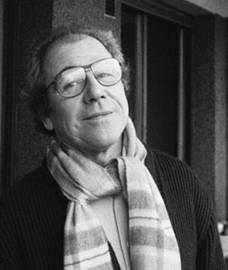ISSN: 1705-6411
Volume 4, Number 3 (October, 2007)
This obituary originally appeared in the Economist.com on March 15, 2007: http://www.economist.com/obituary/displaystory.cfm?story_id=8848290


At some point in his career – neither date nor time being important – Jean Baudrillard took a large red cloth, draped it over a chair in his apartment, and sat on it. He may have smoked or thought for a while, or scratched his nose; a large, dough-like nose, supporting glasses. He then got up, leaving an impression of his body behind. The image pleased him: so much so, that he took a photograph. Since he made no comment on the event (beyond the fact that the chair was later broken), the exact details are conjectural. But by putting the cloth on the chair, and sitting on it, Baudrillard added to the plethora of signs, objects and symbolic acts that made up, in his philosophical system, the whole woof and warp of the 20th century. By getting up, he left behind a “simulacrum” of himself: the truth, as he teasingly put it, that hid the fact that there was no truth there. And by photographing the chair he made it “hyperreal”: an image, which could be reproduced unendingly, of an object that claimed to have meaning and, in fact, had none. Then he went to lunch.
Pourquoi pas? When a simulacrum is also a French philosophe, perhaps the most popular of recent decades, he needs a bottle of Merlot from time to time. And since he spent his days considering the seductive power of images and objects, it was fun to observe that he himself had such a power over the woman in the butcher’s who wrapped up his foie de veau, just because she had seen him on television.
Whether Baudrillard’s world was utter nonsense, or whether it was a profound critique of a consumerist civilization drowning in its own meaninglessness, was a matter for lively debate. Many of his French colleagues found him too much: noisy, mischievous, attached to no school (though he had sat at the feet of both Henri Lefebvre and Roland Barthes in his feverish years at Nanterre, when teaching had been interrupted by clouds of tear-gas and cobblestone-throwing). He said things that got him into trouble. His enthusiasm for the événements of 1968 painted him as a man of the Left, where philosophes belonged as naturally as fish in water; but Baudrillard later broke with Marx, and called him a conservative. What he meant was that both communism and capitalism made human existence a matter of production and exchange, while he preferred to stress its symbolic side.
In any case, in his world, both the liberal and the communist narratives of history had collapsed. “The end of history” was no longer universal capitalism and democracy or the victory of the proletariat. It was summed up for Baudrillard by a man jogging alone, oblivious to his surroundings, hearing only the music of his own sound-system and aware only of the statements he himself was making: health, fashion, endurance. He was running straight ahead, but with no end in view.
Of all the people he offended, none took more umbrage than the Americans. This was interesting, for he was far more popular there than in France, lecturing on various campuses of the University of California and even appearing, at Whiskey Pete’s outside Las Vegas, in a gold lamé jacket. In 1986 he got in a car and drove across the country, both hating and adoring it. He had never been so fully in a land of hyperreality, cluttered with meaningless symbols or, as in Disneyland, with garish synthetic versions of ordinary life. He looked for America, he wrote, in “motels and mineral surfaces …in the speed of the screenplay, in the indifferent reflex of television, in the film of days and nights projected across an empty space.” There he found himself, playing a French philosopher, roaring through “the desert of the real”.
Americans did not like his book. They did not care to be called “the only remaining primitive society”. A few years later, they objected also to Baudrillard’s contention that the first Gulf war of 1991 had never taken place. But, in his view, it had not. The media had created a picture of conflict; but Saddam had deployed his troops, and America had dropped its bombs, as pure statements of power in a vacuum, and the two forces had never met. General Norman Schwarzkopf, the “victor” (though with no victory) had celebrated with a party in Disneyland: QED. All this paled, however, beside Baudrillard’s musings on the terrorist attacks of September 11th 2001. This was the “absolute event”, an inevitable reaction to “insufferable” American power. In the face of overweening globalization, to destroy the twin towers was the only response. The symbol invited its destruction: “It was they who did it, but we who wished it.”
Most Americans decided, at this point, that they did not understand Baudrillard very well. But then few people did. Behind the panache of his ideas – yet sometimes catching acutely the media-dominated triviality of modern life – the man was hidden. “No background,” he would growl, if you asked.
Somewhere, there was German-speaking peasant stock and suspicious parents who wondered what on earth they had produced in this plump and bookish boy. Or perhaps there was really none of that at all: just a photograph of a suggestion of a human shape, on a red cloth on a chair.